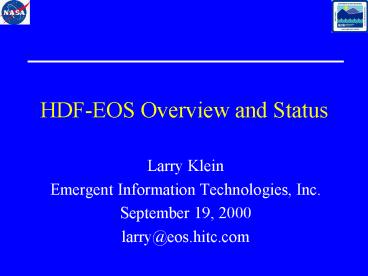HDF-EOS Overview and Status PowerPoint PPT Presentation
Title: HDF-EOS Overview and Status
1
HDF-EOS Overview and Status
- Larry Klein
- Emergent Information Technologies, Inc.
- September 19, 2000
- larry_at_eos.hitc.com
2
What is HDF-EOS?
- An extension to HDF, built with HDF objects.
- A standard for data structures for remote sensing
data and in-situ measurements with - Tightly coupled geolocation information
- Access based on geolocation
- Incorporates ECS metadata attributes.
- Used for many EOS standard products.
3
HDF-EOS File Contents
- Global HDF attributes
- Core Metadata - searchable attributes, copied in
database - Archive Metadata - non-searchable attributes
- Any number of HDF objects specifying HDF-EOS
objects (Grid, Point, Swath) - Structural metadata - links geolocation to
science data - Additional HDF objects.
4
HDF-EOS Grid Structure
- Usage - Data which is organized by regular
geographic spacing, specified by projection
parameters. - Structure
- Any number of 2-D to 8-D data arrays per
structure, one per data type (e.g. temperature) - Geolocation information contained in projection
formula, coupled by structural metadata. - Any number of Grid structures per file allowed.
5
Grid Data Example
6
Grid Data 1 Km. Digital Elevation Model
South Pole
7
HDF-EOS Swath Structure
- Usage - Data which is organized by time,
monotonic geolocation, track parameter. Spacing
can be irregular. - Structure
- Geolocation information stored explictly in
Geolocation Field (2-D array) - Data stored in 2-D or 3-D arrays
- Time stored in 1-D or 2-D array, TAI is standard.
- Geolocation/science data connected by structural
metadata
8
Swath Data Example
9
HDF-EOS Point Structure
- Usage - Data which is specified temporally and/or
spatially, but with no particular organization. - Structure
- Tables (Vdatas) used to store science data at a
particular Lat/Long/Height. - Up to eight levels of data allowed. Structural
metadata specifies relationship between levels.
10
Point Data Example
11
HDF-EOS Interface Schematic
User Application
ECS Metadata Interface
HDF-EOS Interface
Grid
Point
Swath
Low Level HDF
File I/O
12
User Interface
- Access - Open, close objects/files
- Definition - Set key features of data sets
- Basic I/O - Read write data
- Index I/O - Link tables (Point only)
- Inquiry - Return information about data
- Subset - Read data from specific region
- Metadata access (SDP toolkit)
13
Current Archive Holdings
- GSFC DAAC MODIS L1, Atmos./Ocean
- 50 TB, 105,000 granules, 300 GB/day
- will be 1.3 TB / day with addition of MODIS L2
and EOS Aqua data. - EDC DAAC Landsat/ASTER/MODIS Land
- 20 TB, 106,000 granules, 274 GB/day
- Langely DAAC MISR
- 9 TB, 39,000 granules, 88 GB/day
14
Availability
- HDF library - ftp hdf.ncsa.uiuc.edu
- HDF-EOS V2.6 library (HDF4 based)
- http//newsroom.gsfc.nasa.gov/sdptoolkit/toolkit.h
tml - SDP Toolkit library - same location as HDF-EOS
- Platform Support
- DEC, HP, IBM, Sun, SGI, Windows, Linux (soon)
- Language Support - C, C, F77, F90
- HDF4-based library will be supported indefinitely
15
HDF5 - Based Development
- NCSA has introduced HDF5
- A complete rewrite of HDF4, a new user interface.
- Simplified data model
- Breaks 2 GB file size limit
- Potential for parallel I/O, multi-threading
16
HDF5 - Based Development HDF-EOS 3.0
- Development overview
- Maintain current HDF-EOS interface to maximum
extent - Allow all HDF5 features through interface
- Build HDF-EOS (4 to 5) conversion function
- Data production executable can be built with
either or both HDF4 and HDF5 - based library - Support heterogeneous ECS archive (future)
17
Design Schematic
User Application
HDF-EOS Interface Grid, Point, Swath
ECS Metadata Interface
- Common Functions
- Definition, Access, I/O, Inquiry, Subset
HDF4 Interface
HDF5 Interface
Combined HDF4/5 Interface
Build Options
Implemented if required
18
Applications
- H5EOSView - EOSView for HDF5
- Java Browser - Browser for both HDF4 and 5 based
granules - HDF-EOS 4 to 5 converter, HDF-EOS 2.x to HDF-EOS
3.x
19
Schedule
- Jan., 2000 - Beta Version of library
- H5EOSView, Sun, SGI, C support
- Oct. 2000 - Beta2 Version
- Add F77, F90, DEC support
- Local Attributes, Profile Interface,
Chunking/Tiling - HDF-EOS 4 to 5 converter and Java Browser
20
Schedule (cont.)
- Jan. 2001 - SCF version
- add HP, IBM, Windows, Linux (maybe a few months
later), C support - DAAC version (ECS Drop 6B) - Summer 2001.
- Archives can contain both HDF4 and HDF5 - based
granules. - ECS subsystems dont crack granules, but
regression testing needed. - 2 GB size limit is an issue.

